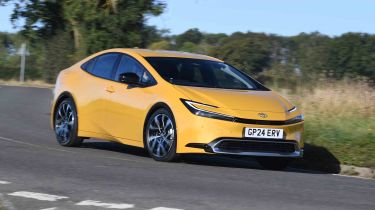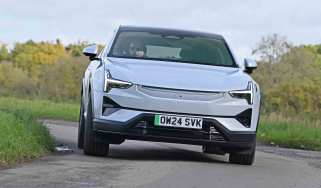Toyota Prius - Engines, performance & drive
The Toyota Prius is better to drive than ever and offers improved refinement

The sporty looks of the fifth-generation Toyota Prius are backed up by a chassis that lives up to those lines.
The latest Prius is almost as good to drive as it is to look at, and while it’s no sports car, as with other Toyotas developed off the TNGA platform, it does a fantastic job of balancing comfort and agility on all kinds of roads. You probably wouldn’t expect to hear that about a Prius, but it’s genuinely good fun to drive.
| Model | Power | 0-62mph | Top speed |
| Prius 2.0 VVTi | 220bhp | 6.8 seconds | 110mph |
What is the Toyota Prius like to drive?
In town
You can get more than 40 miles of real-world range from the electric motor and battery when fully charged and set to electric-only mode. That’s more than enough for most commutes and makes driving in town quiet and relaxing. Even when the engine kicks in, the switchover is super-smooth and so quiet you’ll hardly notice it. It’s only if you apply more throttle that you’ll hear the petrol engine. It’s not a great-sounding unit, but the noise it makes isn’t intrusive.
In 2017 we had a previous-generation Toyota Prius on our long-term test fleet. It ran on 15-inch wheels with huge tyres, and several members of staff described it as the most comfortable car on our fleet by quite a margin. This latest Prius uses the same platform as the older model, but the larger 19-inch alloys of Excel trim aren’t kind to the ride; it’s not as smooth as our old fleet car over bumps and potholes. If you want a comfier model, it might be better to stick to the lesser Design trim, which has 17-inch wheels.
On A- and B-roads
The sleek body and sharp roofline are matched by the driving position, which is surprisingly low but still comfortable. The steering wheel sits deep down, so the instruments can be slightly obscured by the rim. The steering is weighted nicely, but there’s no real feel or feedback from the road – that’s nothing new, though.
Used - available now

2020 Toyota
Prius
34,796 milesAutomaticPetrol1.8L
Cash £16,100
2018 Toyota
Prius
26,136 milesAutomaticPetrol1.8L
Cash £12,495
2020 Toyota
Prius
50,351 milesAutomaticPetrol1.8L
Cash £17,700
2020 Toyota
Prius
44,951 milesAutomaticPetrol1.8L
Cash £19,909The Prius controls body movements well in corners, and the punchy powertrain means it’s genuinely enjoyable to drive on twisty roads, yet it remains comfortable and composed at all times. Forget any preconceptions you may have about the Prius, because keen drivers will be able to appreciate a lot about the quality of the new model’s handling.
On the motorway
There’s a bit of road noise from the eco tyres, but it blends well enough at motorway speeds into the general background hum that it doesn’t become overly intrusive. Wind noise is minimal thanks to the aerodynamic bodywork, but that does have one slight side-effect: the low windscreen and A-pillars mean visibility isn’t as good as we’d like.
0-62mph acceleration and top speed
There’s only one version of the Prius available in the UK right now, the plug-in hybrid. It pairs a 150bhp 2.0-litre petrol engine with a 161bhp electric motor; Toyota quotes a total output of 220bhp. That’s a pretty healthy figure, especially when compared with previous versions of the Prius that felt lethargic.
The Prius Plug-in accelerates from 0-62mph in just 6.8 seconds, which seems bizarrely quick for a car with a Prius badge, but we’re not complaining. The excellent performance comes as power from the electric motor blends seamlessly with that from the petrol engine.
The car uses a CVT gearbox, which is usually the enemy of driving fun. However, the software has come a long way, so in the latest Prius it feels pleasant to use rather than frustrating. It delivers power when you need it but doesn’t raise engine revs to a noisy drone like such technology did in older models. It feels a lot more natural as a result, but it still delivers decent efficiency and performance.








